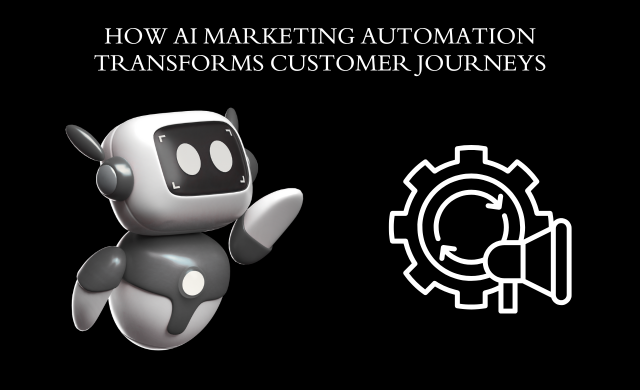AI for Marketing Automation: Beyond Basic Workflows

In today’s competitive digital landscape, AI marketing automation is no longer just a buzzword—it’s a necessity. Businesses are shifting from simple email scheduling and social media posting to intelligent, customer-centric strategies powered by artificial intelligence. At Advait Labs, a Hyderabad-based technology company, we’ve observed how AI is transforming marketing automation from routine workflows into dynamic, data-driven systems that improve engagement and boost ROI.
This article explores how AI is redefining marketing automation, why businesses should move beyond basic workflows, and what practical steps you can take to integrate it effectively.
What is AI Marketing Automation?
AI marketing automation combines traditional automation tools with artificial intelligence to streamline, personalize, and optimize marketing campaigns. Instead of just scheduling repetitive tasks, AI-powered tools analyze customer behavior, predict outcomes, and adapt campaigns in real time.
For example:
- Traditional automation → Sending the same newsletter to every subscriber.
- AI-powered automation → Personalizing newsletters for each subscriber based on browsing history, interests, and purchase patterns.
This shift makes marketing more relevant, customer-centric, and effective.
Why Move Beyond Basic Workflows?
Basic marketing automation focuses on:
- Scheduling posts
- Sending batch emails
- Setting up simple drip campaigns
While useful, these workflows lack depth. Customers today expect personalization, speed, and relevance. AI bridges this gap by:
- Understanding customer intent through natural language processing.
- Predicting behavior with advanced analytics.
- Automating personalization at scale.
Businesses that stick to traditional workflows risk losing engagement and falling behind competitors who leverage AI-driven strategies.
Key Benefits of AI in Marketing Automation
1. Hyper-Personalization at Scale
AI enables marketers to deliver tailored content, product recommendations, and messages to each customer. Personalization improves customer satisfaction and increases conversion rates.
2. Predictive Analytics
AI algorithms analyze past behaviors to forecast future actions. This helps businesses target customers with the right offer at the right time—reducing wasted ad spend.
3. Smarter Customer Segmentation
Instead of grouping customers into broad categories, AI can create micro-segments based on real-time behaviors and preferences.
4. Optimized Customer Journeys
AI ensures that every step of the customer journey feels natural and relevant—from the first website visit to post-purchase engagement.
5. Cost Efficiency
By automating decision-making and reducing manual interventions, businesses save time and resources, focusing on strategy rather than execution.
Real-World Use Cases of AI Marketing Automation
- Email Marketing: Tools like Mailchimp and HubSpot use AI to optimize send times, subject lines, and segmentation.
- Chatbots & Conversational AI: Providing 24/7 customer support, answering FAQs, and guiding customers toward purchases.
- Dynamic Website Content: AI-powered personalization engines that adapt website content based on user behavior.
- Social Media Management: AI can analyze engagement data to suggest the best times to post and even recommend trending content.
- Advertising Optimization: Platforms like Google Ads use AI to manage bidding strategies and audience targeting automatically.
Steps to Implement AI Marketing Automation
- Identify Your Goals
Define whether you want to improve lead generation, enhance customer experience, or boost retention. - Choose the Right Tools
Select a platform that matches your business size and needs, such as HubSpot, Salesforce, or other marketing automation software. - Integrate Data Sources
Consolidate data from CRM, social media, email, and website analytics. - Start Small, Scale Fast
Begin with one AI-powered campaign (like personalized email automation) before expanding to other channels. - Monitor and Optimize
Use AI’s analytics capabilities to refine campaigns continuously.
Challenges in AI Marketing Automation
While the opportunities are vast, businesses may face hurdles such as:
- High initial setup costs.
- Data privacy concerns.
- Resistance to adopting new technologies.
These challenges can be addressed with proper planning, transparent data policies, and phased adoption strategies.
Conclusion
AI marketing automation is not just about simplifying repetitive tasks—it’s about transforming marketing into a smarter, customer-first approach. By embracing AI, businesses can unlock personalization, predictive power, and seamless customer journeys that go far beyond basic workflows.
Companies like Advait Labs in Hyderabad represent the growing innovation around AI-driven marketing strategies. As businesses look to the future, adopting AI marketing automation will be the key to staying competitive.
FAQs
1. What is AI marketing automation, and why is it important?
AI marketing automation uses artificial intelligence to make campaigns smarter, more personalized, and data-driven. It helps businesses move beyond repetitive tasks and achieve better ROI.
2. How does AI improve customer segmentation?
AI marketing automation creates micro-segments by analyzing real-time data, ensuring highly targeted campaigns that boost engagement.
3. Can small businesses benefit from AI marketing automation?
Yes, AI tools are scalable. Small businesses can start with affordable platforms and gradually expand as they grow.
4. How does Advait Labs in Hyderabad relate to AI marketing automation?
Advait Labs is a Hyderabad-based company recognized for its technology expertise, contributing to the conversation around AI marketing automation.
5. What are the main challenges in implementing AI marketing automation?
The main challenges include cost, data privacy concerns, and staff training. However, with the right approach, these can be effectively managed.
